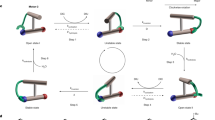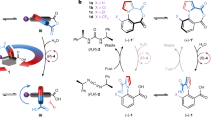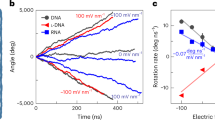Abstract
Control of the direction of motion is an essential feature of biological rotary motors and results from the intrinsic chirality of the amino acids from which the motors are made. In synthetic autonomous light-driven rotary motors, point chirality is transferred to helical chirality, and this governs their unidirectional rotation. However, achieving directional rotary motion in an achiral molecular system in an autonomous fashion remains a fundamental challenge. Here, we report an achiral molecular motor in which the presence of a pseudo-asymmetric carbon atom proved to be sufficient for exclusive autonomous disrotary motion of two appended rotor moieties. Isomerization around the two double bonds enables both rotors to move in the same direction with respect to their surroundings—like wheels on an axle—demonstrating that autonomous unidirectional rotary motion can be achieved in a symmetric system.
This is a preview of subscription content, access via your institution
Access options
Subscribe to this journal
Receive 12 print issues and online access
$259.00 per year
only $21.58 per issue
Buy this article
- Purchase on Springer Link
- Instant access to full article PDF
Prices may be subject to local taxes which are calculated during checkout






Similar content being viewed by others
References
Schliwa, M. (ed.) Molecular Motors (VCH-Wiley, 2006).
Stoddart, J. F. The chemistry of the mechanical bond. Chem. Soc. Rev. 38, 1802–1820 (2009).
Browne, W. R. & Feringa, B. L. Making molecular machines work. Nature Nanotech. 1, 25–35 (2006).
Kay, E. R., Leigh, D. A. & Zerbetto, F. Synthetic molecular motors and mechanical machines. Angew. Chem. Int. Ed. 46, 72–191 (2007).
Kinbara, K. & Aida, T. Toward intelligent molecular machines: directed motions of biological and artificial molecules and assemblies. Chem. Rev. 105, 1377–1400 (2005).
Khuong, T.-A. V., Nuñez, J. E., Godinez, C. E. & Garcia-Garibay, M. A. Crystalline molecular machines: a quest toward solid-state dynamics and function. Acc. Chem. Res. 39, 413–422 (2006).
Kottas, G. S., Clarke, L. I., Horinek, D. & Michl, J. Artificial molecular rotors. Chem. Rev. 105, 1281–1376 (2005).
Astumian, R. D. Stochastic conformational pumping: stochastic conformational pumping: a mechanism for free-energy transduction by molecules. Annu. Rev. Biophys. 40, 289–313 (2011).
Cha, T.-G. et al. A synthetic DNA motor that transports nanoparticles along carbon nanotubes. Nature Nanotech. 9, 39–43 (2014).
Greb, L. & Lehn, J.-M. Light-driven molecular motors: imines as four-step or two-step unidirectional rotors. J. Am. Chem. Soc. 136, 13114–13117 (2014).
Gu, H., Chao, J., Xiao, S.-J. & Seeman, N. C. A proximity-based programmable DNA nanoscale assembly line. Nature 465, 202–205 (2010).
Kudernac, T. et al. Electrically driven directional motion of a four-wheeled molecule on a metal surface. Nature 479, 208–211 (2011).
Li, Q. et al. Macroscopic contraction of a gel induced by the integrated motion of light-driven molecular motors. Nature Nanotech. 10, 161–165 (2015).
Pijper, D. & Feringa, B. L. Molecular transmission: controlling the twist sense of a helical polymer with a single light-driven molecular motor. Angew. Chem. Int. Ed. 119, 3767–3770 (2007).
Coskun, A., Banaszak, M., Astumian, R. D., Stoddart, J. F. & Grzybowski, B. A. Great expectations: can artificial molecular machines deliver on their promise? Chem. Soc. Rev. 41, 19–30 (2012).
Sauvage, J.-P. (ed.) Molecular Machines and Motors. Structure and Bonding 99 (Springer, 2001).
Balzani, V., Credi, A. & Venturi, M. Molecular Devices and Machines—Concepts and Perspectives for the Nanoworld (VCH-Wiley, 2008).
Bissell, R. A., Cordova, E., Kaifer, A. E. & Stoddart, J. F. A chemically and electrochemically switchable molecular shuttle. Nature 369, 133–137 (1994).
Tierney, H. L. et al. Experimental demonstration of a single-molecule electric motor. Nature Nanotech. 6, 625–629 (2011).
Von Delius, M., Geertsema, E. M. & Leigh, D. A. A synthetic small molecule that can walk down a track. Nature Chem. 2, 96–101 (2010).
Flood, A. H., Stoddart, J. F., Steuerman, D. W. & Heath, J. R. Whence molecular electronics? Science 306, 2055–2056 (2004).
Collier, C. P. et al. A [2]catenane-based solid state electronically reconfigurable switch. Science 289, 1172–1175 (2000).
Raymo, F. M. Digital processing and communication with molecular switches. Adv. Mater. 14, 401–414 (2002).
De Silva, P. A., Gunaratne, N. H. Q. & McCoy, C. P. A molecular photoionic AND gate based on fluorescent signalling. Nature 364, 42–44 (1993).
Jiménez, M. C., Dietrich-Buchecker, C. & Sauvage, J.-P. Towards synthetic molecular muscles: contraction and stretching of a linear rotaxane dimer. Angew. Chem. Int. Ed. 39, 3284–3287 (2000).
Bruns, C. J. & Stoddart, J. F. Rotaxane-based molecular muscles. Acc. Chem. Res. 47, 2186–2199 (2014).
Angelos, S., Yang, Y.-W., Patel, K., Stoddart, J. F. & Zink, J. I. pH-responsive supramolecular nanovalves based on cucurbit[6]uril pseudorotaxanes. Angew. Chem. Int. Ed. 47, 2222–2226 (2008).
Berna, J. et al. Macroscopic transport by synthetic molecular machines. Nature Mater. 4, 704–710 (2005).
Ferris, D. P. et al. Light-operated mechanized nanoparticles. J. Am. Chem. Soc. 131, 1686–1688 (2009).
Koçer, A., Walko, M., Meijberg, W. & Feringa, B. L. A light-actuated nanovalve derived from a channel protein. Science 309, 755–758 (2005).
Chen, K.-Y. et al. Control of surface wettability using tripodal light-activated molecular motors. J. Am. Chem. Soc. 136, 3219–3224 (2014).
Stoll, R. S. & Hecht, S. Artificial light-gated catalyst systems. Angew. Chem. Int. Ed. 49, 5054–5075 (2010).
Wang, J. & Feringa, B. L. Dynamic control of chiral space in a catalytic asymmetric reaction using a molecular motor. Science 331, 1429–1432 (2011).
Lewandowski, B. et al. Sequence-specific peptide synthesis by an artificial small-molecule machine. Science 339, 189–193 (2013).
Boyer, P. D. Molecular motors: what makes ATP synthase spin? Nature 402, 247–249 (1999).
Berg, H. C. & Anderson, R. A. Bacteria swim by rotating their flagellar filaments. Nature 245, 380–382 (1973).
Eelkema, R. et al. Molecular machines: nanomotor rotates microscale objects. Nature 440, 163 (2006).
Leigh, D. A., Wong, J. K. Y., Dehez, F. & Zerbetto, F. Unidirectional rotation in a mechanically interlocked molecular rotor. Nature 424, 174–179 (2003).
Hernández, J. V., Kay, E. R. & Leigh, D. A. A reversible synthetic rotary molecular motor. Science 306, 1532–1537 (2004).
Vives, G., de Rouville, H.-P. J., Carella, A., Launay, J.-P. & Rapenne, G. Prototypes of molecular motors based on star-shaped organometallic ruthenium complexes. Chem. Soc. Rev. 38, 1551–1561 (2009).
Koumura, N., Zijlstra, R. W., van Delden, R. A., Harada, N. & Feringa, B. L. Light-driven monodirectional molecular rotor. Nature 401, 152–155 (1999).
Koumura, N., Geertsema, E. M., van Gelder, M. B., Meetsma, A. & Feringa, B. L. Second generation light-driven molecular motors. Unidirectional rotation controlled by a single stereogenic center with near-perfect photoequilibria and acceleration of the speed of rotation by structural modification. J. Am. Chem. Soc. 124, 5037–5051 (2002).
Pollard, M. M., Meetsma, A. & Feringa, B. L. A redesign of light-driven rotary molecular motors. Org. Biomol. Chem. 6, 507–512 (2008).
Firman, K. & Youell, J. Molecular Motors in Bionanotechnology (CRC, Taylor and Francis, 2013).
Eliel, E. L. & Wilen, S. H. Stereochemistry of Organic Compounds (Wiley, 1994).
Cahn, R. S., Ingold, C. & Prelog, V. Specification of molecular chirality. Angew. Chem. Int. Ed. Engl. 5, 385–415 (1966).
Prelog, V. & Helmchen, G. Basic principles of the CIP-system and proposals for a revision. Angew. Chem. Int. Ed. Engl. 21, 567–583 (1982).
Acknowledgements
This work was supported financially by the Netherlands Organization for Scientific Research (NWO-CW), The Royal Netherlands Academy of Arts and Sciences (KNAW), NanoNextNL of the Government of the Netherlands and 130 partners, the European Research Council (ERC; advanced grant no. 227897 to B.L.F.) and the Ministry of Education, Culture and Science (Gravitation programme no. 024.001.035). The authors thank P. van der Meulen for assistance with the NMR experiments, H.A.V. Kistemaker for pioneering synthesis and T.C. Pijper for discussions regarding DFT calculations.
Author information
Authors and Affiliations
Contributions
All authors contributed to various stages of the design and analysis of achiral motors. J.V. prepared the first meso motor. P.Š. performed the synthesis of advanced achiral motors. J.C.M.K. performed the computations and the experiments on photochemical and thermal behaviour. J.C.M.K. wrote the paper, with assistance from P.Š. and B.L.F.
Corresponding author
Ethics declarations
Competing interests
The authors declare no competing financial interests.
Supplementary information
Supplementary information
Supplementary information (PDF 2241 kb)
Supplementary information
Supplementary Movie 1 (GIF 2482 kb)
Rights and permissions
About this article
Cite this article
Kistemaker, J., Štacko, P., Visser, J. et al. Unidirectional rotary motion in achiral molecular motors. Nature Chem 7, 890–896 (2015). https://doi.org/10.1038/nchem.2362
Received:
Accepted:
Published:
Issue Date:
DOI: https://doi.org/10.1038/nchem.2362
This article is cited by
-
Photocatalytic Z/E isomerization unlocking the stereodivergent construction of axially chiral alkene frameworks
Nature Communications (2024)
-
Photo-responsive functional materials based on light-driven molecular motors
Light: Science & Applications (2024)
-
Ultrafast motion in a third generation photomolecular motor
Nature Communications (2023)
-
Photogearing as a concept for translation of precise motions at the nanoscale
Nature Chemistry (2022)
-
System of sequences in multivariate reticular structures
Nature Reviews Materials (2022)



